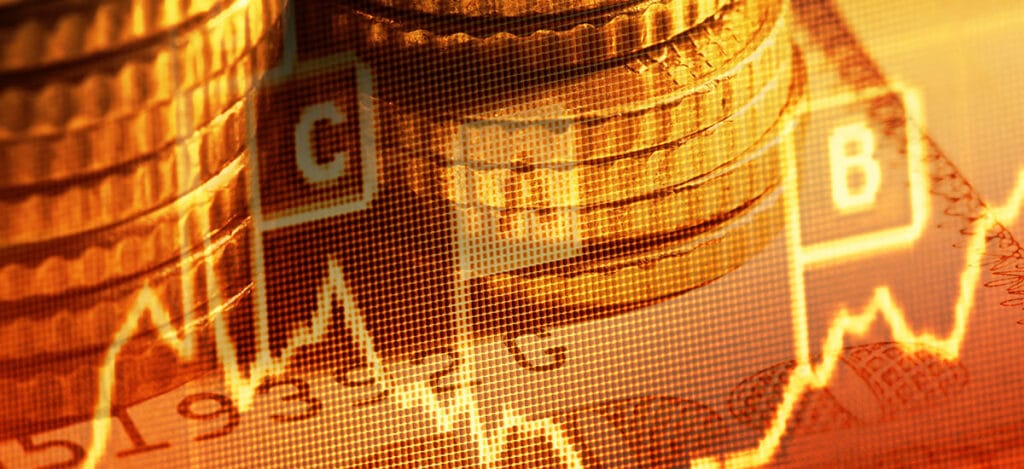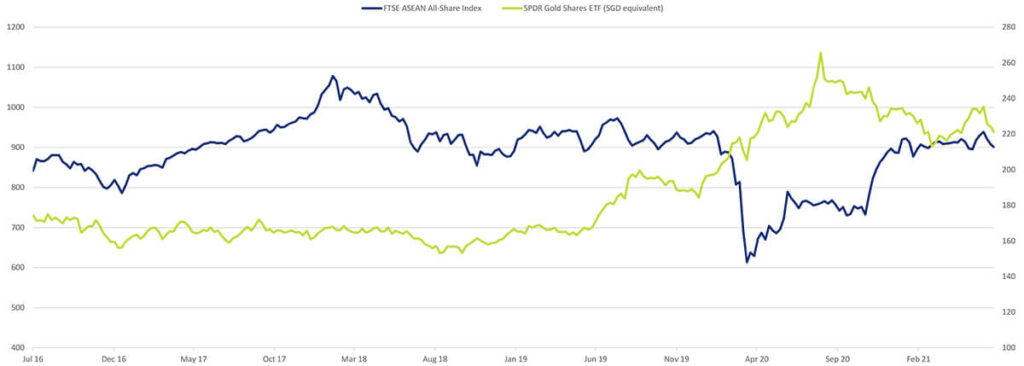Navigate
Article List
- SBMA Successfully Concludes First Virtual APPMC
By Albert Cheng, CEO, SBMA
- APPMC: Market Updates
By SBMA
- The Significance of SPDR Gold Shares Dual Currency Trading
By Geoff Howie, Market Strategist, Singapore Exchange
- Our Vision for the Gold Market
By Andrew Naylor, Head of ASEAN and Public Policy, World Gold Council
- The New Investment Landscape is Green
By Vikas Shenoy, Head of APAC Origination & Partnerships, Trovio
- Gaining Exposure to Gold via Streaming and Royalty Companies
By Emil Kalinowski, Researcher, Wheaton Precious Metals
- There is Still Mettle Left in the Precious Metals
By Bart Melek, Global Head of Commodity Strategy, TD Securities
- SBMA News
By Albert Cheng, CEO, SBMA
Article List
- SBMA Successfully Concludes First Virtual APPMC
By Albert Cheng, CEO, SBMA
- APPMC: Market Updates
By SBMA
- The Significance of SPDR Gold Shares Dual Currency Trading
By Geoff Howie, Market Strategist, Singapore Exchange
- Our Vision for the Gold Market
By Andrew Naylor, Head of ASEAN and Public Policy, World Gold Council
- The New Investment Landscape is Green
By Vikas Shenoy, Head of APAC Origination & Partnerships, Trovio
- Gaining Exposure to Gold via Streaming and Royalty Companies
By Emil Kalinowski, Researcher, Wheaton Precious Metals
- There is Still Mettle Left in the Precious Metals
By Bart Melek, Global Head of Commodity Strategy, TD Securities
- SBMA News
By Albert Cheng, CEO, SBMA
The Significance of SPDR Gold Shares Dual Currency Trading
By Chinese Gold and Silver Exchange
Published on June 10, 2021


Contributor GEOFF HOWIE is the Singapore Exchange’s Market Strategist, with more than 20 years of experience in financial markets and economics. He has a strong background in global macroeconomics and a reputation for expeditiously identifying key market drivers and their impact across major asset classes.
Effective 30 June, dual currency trading will be introduced to the SPDR Gold Shares ETF which will commence trading in a secondary currency of SGD, with the primary trading currency remaining the USD.
As the unit holdings executed via SGD and USD counters are custodised in a consolidated pool at the depository, investors can buy one currency counter and sell in the other currency counter.
The ETF, also included under the CPFIS-OA, has a minimum board lot size of five units (approx. 0.47 ounces of gold), which at a current unit price of US$166, has a value of US$830 (approx. S$1,110). The SPDR Gold Shares ETF was the most traded ETF listed in Singapore in 2019 and 2020, and the second most traded ETF in the 2021 year to date.
The SPDR Gold Shares ETF has averaged daily turnover close to US$4 million since the end of 2019, which compares to average daily turnover of US$1.7 million for the three years pre-COVID.
Recent Volatility, the SGD and the SPDR Gold Shares ETF
The past five years have seen the SPDR Gold Shares ETF generate a 32% return in USD terms, while the regional FTSE ASEAN All-Share Index generated an 8% price return, with reinvested dividends boosting the total return to 18.8% (also in USD terms). While both benchmarks generated gains over the five years, with the SPDR Gold Shares ETF return largely unchanged at 31% in SGD terms, periods of heightened volatility saw a number of performance divergences across the index, ETF and SGD/USD. So much so, that over the past five years, the daily moves of the SPDR Gold Shares ETF have been inversely correlated to the FTSE ASEAN All-Share Index. When changing the denomination of the SPDR Gold Shares ETF to the SGD, the ETF’s inverse correlation to FTSE ASEAN All-Share Index was increased further. One possible reason for this was that the SPDR Gold Shares ETF, and to a lesser extent, the SGD, have both appealed as less riskier assets that served investors seeking safer havens in recent years.
For instance, during the market volatility between 15 January 2020 and 15 April 2020 the FTSE ASEAN All-Share Index, which is denominated in USD, declined 26.5% while the SPDR Gold Shares ETF in USD terms gained 9.8%. The USD continues to remain the most used international currency used for international and intra-regional trade. During the four months, the SPDR Gold Shares ETF gained 16% in SGD terms, outpacing the 9.8% gain for the ETF in USD terms. This meant the simple inverse correlation of the SPDR Gold Shares ETF in SGD terms to the FTSE ASEAN All-Share Index in USD terms, for the short period, was exacerbated further, in this case, from -9% to -56%.
From 14 January 2021 to 1 February 2021, the FTSE ASEAN All-Share Index declined 4.6% in USD terms, while the SPDR Gold Shares ETF in USD terms gained 1.1% and the SPDR Gold Shares ETF in SGD terms gained 1.7%. More recently, the three weeks from 29 April to 20 May saw the FTSE ASEAN All-Share Index decline 3% in USD terms, while the SPDR Gold Shares ETF in USD terms gained 5.1% and the SPDR Gold Shares ETF in SGD terms gained 5.5%.
FTSE ASEAN All-Share Index vs SPDR Gold Shares ETF

Note these educative examples of inverse correlation were observed during increased market volatility that coincided with risk-off like themes making the headlines, with the key caveat that past cross-asset flows do not necessarily foreshadow future cross-asset flows. As a global asset class, gold has multiple attributes with portfolio diversification a popular application. Including assets with a low correlation to each other does help reduce overall portfolio risk and the World Gold Council suggests that when investors add risky assets, gold should make up between 2% and 10% of the portfolio.
With Singapore’s open Capital Account, the International Monetary Fund noted in 2019 that due to Singapore’s status as a trade and financial centre in Asia, changes in market sentiment can affect Singapore significantly, and that increased risk aversion in the region, for instance, may lead to inflows to Singapore, given its status as a regional safe haven, while global stress may lead to outflow.
Broader Applications
Much of the ASEAN population maintains a penchant for gold. The SBMA maintains that gold has played a very important role in ASEAN and is closely connected with the life and culture of the people in the region, and has been used often in the past as a medium of exchange and a unit of measurement. Back in 2017, the SBMA highlighted a regional propensity to buy gold jewellery, not only for use as accessories or gifts for cultural or religious ceremonies such as weddings, festivals and other special occasions, but also as a storage of wealth.
The SPDR Gold Shares ETF is a modern, cost-efficient and secure way to gain access to the gold market without having to pay the transportation, storage and insurance costs of holding physical gold
The SPDR Gold Shares ETF is also among the most traded ETFs across the region. The key attribute that State Street Global Advisors often associate with the ETF is its provision of a modern, cost-efficient and secure way to gain access to the gold market without having to pay the transportation, storage and insurance costs of holding physical gold.
Aside from gold helping manage risk and volatility as discussed above, gold may help preserve purchasing power. The leading ETF issuer maintains that the gold prices are influenced by multiple factors ranging from central bank policies and interest rates to emerging market demand and mining production and as a result, there is a diverse set of global drivers that impact the price of gold beyond localised events. State Street Global Advisors suggest that this could support gold prices during periods of local currency depreciation and may help it act as a hedge against global inflation.
Since its inception in the United States in November 2004, the ETF has generated an annualised return of 8% in USD terms or 7% in SGD terms through to 28 June. The SPDR Gold Shares ETF was subsequently listed on SGX in October 2006, and has generated an annualised return of 8% in USD terms or 6% in SGD terms through to 28 June. Globally, the SPDR Gold Trust currently maintains total net assets of US$64 billion.

Contributor GEOFF HOWIE is the Singapore Exchange’s Market Strategist, with more than 20 years of experience in financial markets and economics. He has a strong background in global macroeconomics and a reputation for expeditiously identifying key market drivers and their impact across major asset classes.
























